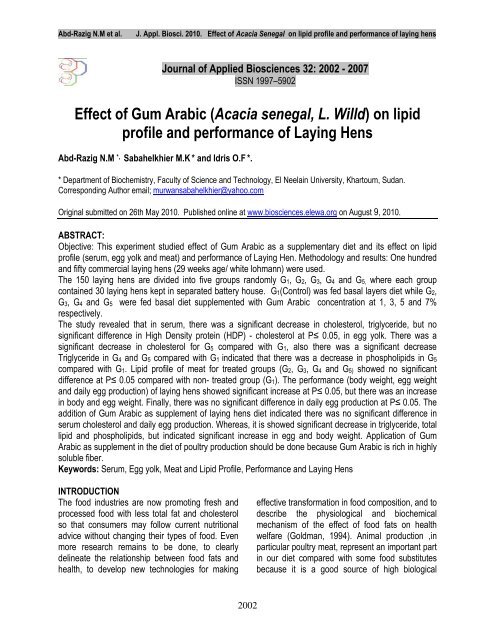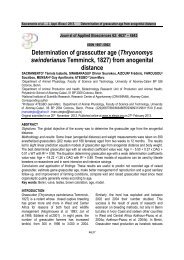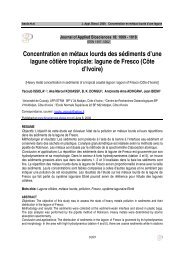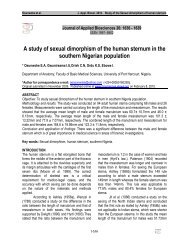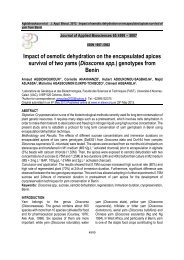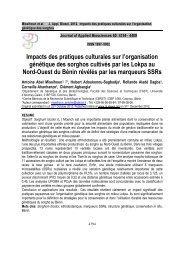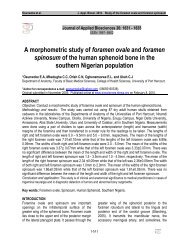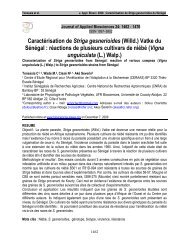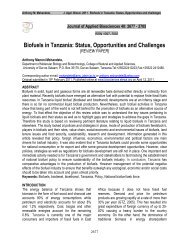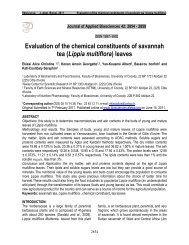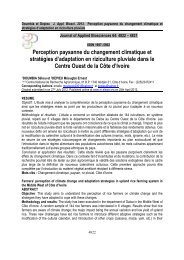Effect of Gum Arabic (Acacia senegal, L. Willd) on lipid - M.elewa.org ...
Effect of Gum Arabic (Acacia senegal, L. Willd) on lipid - M.elewa.org ...
Effect of Gum Arabic (Acacia senegal, L. Willd) on lipid - M.elewa.org ...
Create successful ePaper yourself
Turn your PDF publications into a flip-book with our unique Google optimized e-Paper software.
Abd-Razig N.M et al. .… J. Appl. Biosci. 2010. <str<strong>on</strong>g>Effect</str<strong>on</strong>g> <str<strong>on</strong>g>of</str<strong>on</strong>g> <str<strong>on</strong>g>Acacia</str<strong>on</strong>g> Senegal <strong>on</strong> <strong>lipid</strong> pr<str<strong>on</strong>g>of</str<strong>on</strong>g>ile and performance <str<strong>on</strong>g>of</str<strong>on</strong>g> laying hens<str<strong>on</strong>g>Effect</str<strong>on</strong>g> <str<strong>on</strong>g>of</str<strong>on</strong>g> <str<strong>on</strong>g>Gum</str<strong>on</strong>g> <str<strong>on</strong>g>Arabic</str<strong>on</strong>g> (<str<strong>on</strong>g>Acacia</str<strong>on</strong>g> <str<strong>on</strong>g>senegal</str<strong>on</strong>g>, L. <str<strong>on</strong>g>Willd</str<strong>on</strong>g>) <strong>on</strong> <strong>lipid</strong>pr<str<strong>on</strong>g>of</str<strong>on</strong>g>ile and performance <str<strong>on</strong>g>of</str<strong>on</strong>g> Laying HensAbd-Razig N.M *, Sabahelkhier M.K * and Idris O.F *.Journal <str<strong>on</strong>g>of</str<strong>on</strong>g> Applied Biosciences 32: 2002 - 2007ISSN 1997–5902* Department <str<strong>on</strong>g>of</str<strong>on</strong>g> Biochemistry, Faculty <str<strong>on</strong>g>of</str<strong>on</strong>g> Science and Technology, El Neelain University, Khartoum, Sudan.Corresp<strong>on</strong>ding Author email; murwansabahelkhier@yahoo.comOriginal submitted <strong>on</strong> 26th May 2010. Published <strong>on</strong>line at www.biosciences.<strong>elewa</strong>.<strong>org</strong> <strong>on</strong> August 9, 2010.ABSTRACT:Objective: This experiment studied effect <str<strong>on</strong>g>of</str<strong>on</strong>g> <str<strong>on</strong>g>Gum</str<strong>on</strong>g> <str<strong>on</strong>g>Arabic</str<strong>on</strong>g> as a supplementary diet and its effect <strong>on</strong> <strong>lipid</strong>pr<str<strong>on</strong>g>of</str<strong>on</strong>g>ile (serum, egg yolk and meat) and performance <str<strong>on</strong>g>of</str<strong>on</strong>g> Laying Hen. Methodology and results: One hundredand fifty commercial laying hens (29 weeks age/ white lohmann) were used.The 150 laying hens are divided into five groups randomly G1, G2, G3, G4 and G5, where each groupc<strong>on</strong>tained 30 laying hens kept in separated battery house. G1(C<strong>on</strong>trol) was fed basal layers diet while G2,G3, G4 and G5 were fed basal diet supplemented with <str<strong>on</strong>g>Gum</str<strong>on</strong>g> <str<strong>on</strong>g>Arabic</str<strong>on</strong>g> c<strong>on</strong>centrati<strong>on</strong> at 1, 3, 5 and 7%respectively.The study revealed that in serum, there was a significant decrease in cholesterol, triglyceride, but nosignificant difference in High Density protein (HDP) - cholesterol at P≤ 0.05, in egg yolk. There was asignificant decrease in cholesterol for G5 compared with G1, also there was a significant decreaseTriglyceride in G4 and G5 compared with G1 indicated that there was a decrease in phospho<strong>lipid</strong>s in G5compared with G1. Lipid pr<str<strong>on</strong>g>of</str<strong>on</strong>g>ile <str<strong>on</strong>g>of</str<strong>on</strong>g> meat for treated groups (G2, G3, G4 and G5) showed no significantdifference at P≤ 0.05 compared with n<strong>on</strong>- treated group (G1). The performance (body weight, egg weightand daily egg producti<strong>on</strong>) <str<strong>on</strong>g>of</str<strong>on</strong>g> laying hens showed significant increase at P≤ 0.05, but there was an increasein body and egg weight. Finally, there was no significant difference in daily egg producti<strong>on</strong> at P≤ 0.05. Theadditi<strong>on</strong> <str<strong>on</strong>g>of</str<strong>on</strong>g> <str<strong>on</strong>g>Gum</str<strong>on</strong>g> <str<strong>on</strong>g>Arabic</str<strong>on</strong>g> as supplement <str<strong>on</strong>g>of</str<strong>on</strong>g> laying hens diet indicated there was no significant difference inserum cholesterol and daily egg producti<strong>on</strong>. Whereas, it is showed significant decrease in triglyceride, total<strong>lipid</strong> and phospho<strong>lipid</strong>s, but indicated significant increase in egg and body weight. Applicati<strong>on</strong> <str<strong>on</strong>g>of</str<strong>on</strong>g> <str<strong>on</strong>g>Gum</str<strong>on</strong>g><str<strong>on</strong>g>Arabic</str<strong>on</strong>g> as supplement in the diet <str<strong>on</strong>g>of</str<strong>on</strong>g> poultry producti<strong>on</strong> should be d<strong>on</strong>e because <str<strong>on</strong>g>Gum</str<strong>on</strong>g> <str<strong>on</strong>g>Arabic</str<strong>on</strong>g> is rich in highlysoluble fiber.Keywords: Serum, Egg yolk, Meat and Lipid Pr<str<strong>on</strong>g>of</str<strong>on</strong>g>ile, Performance and Laying HensINTRODUCTIONThe food industries are now promoting fresh andprocessed food with less total fat and cholesterolso that c<strong>on</strong>sumers may follow current nutriti<strong>on</strong>aladvice without changing their types <str<strong>on</strong>g>of</str<strong>on</strong>g> food. Evenmore research remains to be d<strong>on</strong>e, to clearlydelineate the relati<strong>on</strong>ship between food fats andhealth, to develop new technologies for makingeffective transformati<strong>on</strong> in food compositi<strong>on</strong>, and todescribe the physiological and biochemicalmechanism <str<strong>on</strong>g>of</str<strong>on</strong>g> the effect <str<strong>on</strong>g>of</str<strong>on</strong>g> food fats <strong>on</strong> healthwelfare (Goldman, 1994). Animal producti<strong>on</strong> ,inparticular poultry meat, represent an important partin our diet compared with some food substitutesbecause it is a good source <str<strong>on</strong>g>of</str<strong>on</strong>g> high biological2002
Abd-Razig N.M et al. .… J. Appl. Biosci. 2010. <str<strong>on</strong>g>Effect</str<strong>on</strong>g> <str<strong>on</strong>g>of</str<strong>on</strong>g> <str<strong>on</strong>g>Acacia</str<strong>on</strong>g> Senegal <strong>on</strong> <strong>lipid</strong> pr<str<strong>on</strong>g>of</str<strong>on</strong>g>ile and performance <str<strong>on</strong>g>of</str<strong>on</strong>g> laying hensprotein value and low total fat quantity. It alsoprovides Ir<strong>on</strong> and Zinc metal <str<strong>on</strong>g>of</str<strong>on</strong>g> high bio-availabilityin low quantity compared with the red meat. It hasa significant amount <str<strong>on</strong>g>of</str<strong>on</strong>g> vitamin B such as Thiamin,Rib<str<strong>on</strong>g>of</str<strong>on</strong>g>lavin and Niacin (Oves<strong>on</strong>. 2003).<str<strong>on</strong>g>Gum</str<strong>on</strong>g> <str<strong>on</strong>g>Arabic</str<strong>on</strong>g> (GA) is dietary fiber that is derivedfrom dried exudates <str<strong>on</strong>g>of</str<strong>on</strong>g> <str<strong>on</strong>g>Acacia</str<strong>on</strong>g> <str<strong>on</strong>g>senegal</str<strong>on</strong>g> (Nasir,2008), It c<strong>on</strong>tains <str<strong>on</strong>g>of</str<strong>on</strong>g> high molecular weight(lipoprotein) and low molecular weight(heterogeneous gum polysaccharides). It isindicated that the supplementati<strong>on</strong> with <str<strong>on</strong>g>Gum</str<strong>on</strong>g><str<strong>on</strong>g>Arabic</str<strong>on</strong>g> increases fecal nitrogen excreti<strong>on</strong> andlowers serum urea nitrogen c<strong>on</strong>centrati<strong>on</strong> inchr<strong>on</strong>ic renal failure patients c<strong>on</strong>suming a lowprotein diet (Bliss, et al. 1996). Increasing the ratio<str<strong>on</strong>g>of</str<strong>on</strong>g> the <str<strong>on</strong>g>Gum</str<strong>on</strong>g> <str<strong>on</strong>g>Arabic</str<strong>on</strong>g> (5- 15%) in the basal a layersdiet significantly reduced serum cholesterol in agradual manner and c<strong>on</strong>sequently in egg wherelower yolk cholesterol was observed bySabahelkhier (2008).Cholesterol, the mostimportant sterol, is found <strong>on</strong>ly in food derived fromanimal sources such as egg yolk, liver and kidney(Johns<strong>on</strong>, and Standers, 1994). The body <str<strong>on</strong>g>of</str<strong>on</strong>g>human can not breakdown the sterol nucleus, but itis either excreted unchanged in bile or c<strong>on</strong>vertedto bile acids and then excreted. Both bile acids andMATERIAL AND METHODSMaterials: The current experiment was c<strong>on</strong>ductedin Alhaj Suleiman Project for Poultry Producti<strong>on</strong> inKhartoum State. The biochemical analysis wasd<strong>on</strong>e in Department <str<strong>on</strong>g>of</str<strong>on</strong>g> Biochemistry, Faculty <str<strong>on</strong>g>of</str<strong>on</strong>g>Veterinary, and University <str<strong>on</strong>g>of</str<strong>on</strong>g> Khartoum. Onehundred and fifty commercial laying hens (Whitelohmann) were divided into five groups namely: G1without <str<strong>on</strong>g>Gum</str<strong>on</strong>g> <str<strong>on</strong>g>Arabic</str<strong>on</strong>g> as c<strong>on</strong>trol, G2 received 1%<str<strong>on</strong>g>Gum</str<strong>on</strong>g> <str<strong>on</strong>g>Arabic</str<strong>on</strong>g>, G3 received 3% <str<strong>on</strong>g>Gum</str<strong>on</strong>g> <str<strong>on</strong>g>Arabic</str<strong>on</strong>g>, G4cholesterol undergo an entroheptic circulati<strong>on</strong>(Backett, et al. 2005).Triglycerides can be hydrolysized, re-synthesized,and utilized as source <str<strong>on</strong>g>of</str<strong>on</strong>g> energy or employed in thesynthesis <str<strong>on</strong>g>of</str<strong>on</strong>g> additi<strong>on</strong>al <strong>lipid</strong> such as phospho<strong>lipid</strong>sand cholesterol (Goldman, 1994). There are fourtypes <str<strong>on</strong>g>of</str<strong>on</strong>g> triglycerides which differ in their amount <str<strong>on</strong>g>of</str<strong>on</strong>g>protein and <strong>lipid</strong>: Chylomicr<strong>on</strong>, derived fromintestinal absorpti<strong>on</strong> <str<strong>on</strong>g>of</str<strong>on</strong>g> triglycerides: Very lowdensity protein (VLDP), derived from the liver forexport triglycerides: High density protein (HDP)and Low density protein (LDP) for cholesteroltransport (Marray, 1999).For good health and performance <str<strong>on</strong>g>of</str<strong>on</strong>g> laying hens,their diet must c<strong>on</strong>tain all the know nutrients(Water, protein, carbohydrates, vitamin andminerals) in the proper amount because anyinsufficiency <str<strong>on</strong>g>of</str<strong>on</strong>g> these nutrients leads to po<strong>org</strong>rowth, reproducti<strong>on</strong>, eggshell quality, egg sizeand egg producti<strong>on</strong> (Damr<strong>on</strong> and Sloan, 2003).The aim <str<strong>on</strong>g>of</str<strong>on</strong>g> this study was to investigate the effect<str<strong>on</strong>g>of</str<strong>on</strong>g> <str<strong>on</strong>g>Gum</str<strong>on</strong>g> <str<strong>on</strong>g>Arabic</str<strong>on</strong>g> <strong>on</strong> the <strong>lipid</strong> pr<str<strong>on</strong>g>of</str<strong>on</strong>g>ile <str<strong>on</strong>g>of</str<strong>on</strong>g> serum, eggyolk and meat (triglycerides, phospho<strong>lipid</strong>s andcholesterol) and performance (body weight, eggweight and daily egg producti<strong>on</strong>) <str<strong>on</strong>g>of</str<strong>on</strong>g> the layinghens.received 5% <str<strong>on</strong>g>Gum</str<strong>on</strong>g> <str<strong>on</strong>g>Arabic</str<strong>on</strong>g> and G5 received 7%<str<strong>on</strong>g>Gum</str<strong>on</strong>g> <str<strong>on</strong>g>Arabic</str<strong>on</strong>g>. Each group c<strong>on</strong>tained 30 hens (29weeks <str<strong>on</strong>g>of</str<strong>on</strong>g> age). Before start <str<strong>on</strong>g>of</str<strong>on</strong>g> the experiment allthe hens were fed the basal diet without <str<strong>on</strong>g>Gum</str<strong>on</strong>g><str<strong>on</strong>g>Arabic</str<strong>on</strong>g> for two weeks for adaptati<strong>on</strong> as shown inTable (1). The water was distributed to the hens bypipe with nipple drinkers to each cage. Period <str<strong>on</strong>g>of</str<strong>on</strong>g>experiment three m<strong>on</strong>ths.Table 1: Basal diet formulati<strong>on</strong>.Ingredients S<strong>org</strong>hum Groundnut cake Wheat bran C<strong>on</strong>centrates Limest<strong>on</strong>e TotalKg\t<strong>on</strong> 600 165 90 50 95 1000Egg samples: 10 eggs from each group werecollected manually and randomly every ten daysfor biochemical analysis. Blood samples: 10blood samples were collected randomly from eachgroup every ten days. Bloods were collected fromthe hen's wing by using sterilizing syringes andneedle. Two ml <str<strong>on</strong>g>of</str<strong>on</strong>g> blood was taken from each henand put in plain c<strong>on</strong>tainer and allowed to clot. Then2003
Abd-Razig N.M et al. .… J. Appl. Biosci. 2010. <str<strong>on</strong>g>Effect</str<strong>on</strong>g> <str<strong>on</strong>g>of</str<strong>on</strong>g> <str<strong>on</strong>g>Acacia</str<strong>on</strong>g> Senegal <strong>on</strong> <strong>lipid</strong> pr<str<strong>on</strong>g>of</str<strong>on</strong>g>ile and performance <str<strong>on</strong>g>of</str<strong>on</strong>g> laying hensthe sample was centrifuged at 3000 rpm for tenminutes to separate serum from blood cell. Theserum was kept in test tubes – 20 o C and thenused to estimate cholesterol, triglycerides andHDP cholesterol.Meat samples: Two meatsamples were collected randomly from each groupevery ten days. Laying hens were slaughtered andimmediately the muscle <str<strong>on</strong>g>of</str<strong>on</strong>g> the thigh was put inc<strong>on</strong>tainer and kept in a freezer for estimati<strong>on</strong> <str<strong>on</strong>g>of</str<strong>on</strong>g>total <strong>lipid</strong>, Cholesterol, Phospho<strong>lipid</strong>s andtriglycerides.Performance (body weight, egg weight anddaily egg producti<strong>on</strong>) <str<strong>on</strong>g>of</str<strong>on</strong>g> laying hens: It wasdetermined every ten days.Methods:Serum cholesterol: It was determined accordingto method described by Meiattini, et al. (1978) andAllain, et al. (1974).Serum triglycerides: It wasdetermined according to method described byFriedman and Young (1997) and, Fassati andPrencips (1982).Serum high density protein (HDP): It wasdetermined according to method described byBurstein, et al. (1980) and Grove (1979).Extracti<strong>on</strong> <str<strong>on</strong>g>of</str<strong>on</strong>g> <strong>lipid</strong> from egg yolk and meat(chlor<str<strong>on</strong>g>of</str<strong>on</strong>g>orm: methanol, 2:1 v/v): It was extractedfrom egg yolk according to methods modified byOverturp dryer (1969) and Folich, et al. (1952).Statistical analysis: The experiment wasc<strong>on</strong>ducted under the completely randomizeddesign. Statistical analysis was performed by using<strong>on</strong>e-way ANOVA for Statistical Package for SocialScience (SPSS) s<str<strong>on</strong>g>of</str<strong>on</strong>g>tware. Differences werec<strong>on</strong>sidered significant at P≤ 0.05.RESULTS AND DISCUSSIONTable 2: <str<strong>on</strong>g>Effect</str<strong>on</strong>g> <str<strong>on</strong>g>of</str<strong>on</strong>g> <str<strong>on</strong>g>Gum</str<strong>on</strong>g> <str<strong>on</strong>g>Arabic</str<strong>on</strong>g> <strong>on</strong> <strong>lipid</strong> pr<str<strong>on</strong>g>of</str<strong>on</strong>g>ile (Total <strong>lipid</strong>, Cholesterol, Triglyceride, phospho<strong>lipid</strong>s and HDP)<str<strong>on</strong>g>of</str<strong>on</strong>g> serum, egg yolk and meat <str<strong>on</strong>g>of</str<strong>on</strong>g> laying hensSerum Egg yolk MeatGroups TL Ch Tg HDP TL Ch Tg Pl TL Ch Tg Plmg/dl mg/dl mg/dl mg/dl mg/dl mg/dl mg/dl mg/dl mg/dl mg/dl mg/dl mg/dlG 1 0%) ND 108±2 448±9 21±1 179±6 18±0.7 63±3 a44±2 23±5 6±0.8 10±3 6±1G 2 1%) ND 104±3 447±8 21±1 178±5 16±0.6 63±3 42±3 23±3 7±0.5 9±1 7±1G 3( 3% ND 104±3 436±9 21±1 178±3 16±0.6 57±2 40±1 26±3 9±1.0 9±1 8±1G 4(5 ) ND 104±2 436±8 21±1 178±4 16±0.6 55±2a39±2 28±2 9±0.8 9±3 8±1G 5 7%) ND 102±2 421±8 21±1 174±3 16±0.4 50±2a39±2 30±3 9±0.6 9±2 8±1ND = Not Determine, TL =Total Lipid, Ch = Cholesterol, TG= Triglyceride, HDP = High Density Protein,PL= Phospho<strong>lipid</strong>sMean values with same letters within column are significant difference at P ≤ 0.05Lipid pr<str<strong>on</strong>g>of</str<strong>on</strong>g>ile <str<strong>on</strong>g>of</str<strong>on</strong>g> laying hen: Table 2 indicates thetotal cholesterol <str<strong>on</strong>g>of</str<strong>on</strong>g> serum for G1, G2, G3, G4 and G5at 108, 106, 105, 104 and 102 mg /dl, respectively.These findings indicate that a significant differencein the reducti<strong>on</strong> <str<strong>on</strong>g>of</str<strong>on</strong>g> total cholesterol <str<strong>on</strong>g>of</str<strong>on</strong>g> the serumcomparing with G1 (c<strong>on</strong>trol) at P ≤ 0.05, but itshowed no significances in the diet supplementedwith <str<strong>on</strong>g>Gum</str<strong>on</strong>g> <str<strong>on</strong>g>Arabic</str<strong>on</strong>g> at c<strong>on</strong>centrati<strong>on</strong> <str<strong>on</strong>g>of</str<strong>on</strong>g> 1, 3, 5 and 7mg /dl. Total triglycerides <str<strong>on</strong>g>of</str<strong>on</strong>g> serum for G1, G2, G3,G4 and G5 are 448, 447, 436, 436 and 421 mg /dl,respectively. These results illustrate that there isno significant difference in the diet supplementedwith <str<strong>on</strong>g>Gum</str<strong>on</strong>g> <str<strong>on</strong>g>Arabic</str<strong>on</strong>g> except for G5 which showed asignificant difference at P ≤ 0.05. These finding areinline with results that obtained by McNaught<strong>on</strong>(1978).The high density protein <str<strong>on</strong>g>of</str<strong>on</strong>g> serum is thesame (21mg\dl) as for c<strong>on</strong>trol and treated groups.These findings are supported by the results givenby Davids<strong>on</strong> (1990). Total <strong>lipid</strong>s <str<strong>on</strong>g>of</str<strong>on</strong>g> egg yolk for G1,G2, G3, G4 and G5 are 179, 178, 178, 178 and 1742004
Abd-Razig N.M et al. .… J. Appl. Biosci. 2010. <str<strong>on</strong>g>Effect</str<strong>on</strong>g> <str<strong>on</strong>g>of</str<strong>on</strong>g> <str<strong>on</strong>g>Acacia</str<strong>on</strong>g> Senegal <strong>on</strong> <strong>lipid</strong> pr<str<strong>on</strong>g>of</str<strong>on</strong>g>ile and performance <str<strong>on</strong>g>of</str<strong>on</strong>g> laying hensmg/dl, respectively. These findings showed nosignificant difference for the groups except G5which showed significant difference at P ≤ 0.05.These results are inline with results reported byJensen, et al. (1993). Total triglycerides <str<strong>on</strong>g>of</str<strong>on</strong>g> egg yolkfor G1, G2 and G3 are the same (63 mg/dl) whiletotal triglycerides <str<strong>on</strong>g>of</str<strong>on</strong>g> egg yolk for G3, G4 and G5 are57, 55 and 50 mg\ dl, respectively. These resultshave c<strong>on</strong>firmed that diet supplemented with <str<strong>on</strong>g>Gum</str<strong>on</strong>g><str<strong>on</strong>g>Arabic</str<strong>on</strong>g> indicated a reducti<strong>on</strong> in the total triglyceridefor egg yolk in all groups compared with G1, butthe reducti<strong>on</strong> is not significantly different for othergroups except G1 and G5 that showed a highsignificant difference at P ≤ 0.05. These findingsare supported by results given by McNaught<strong>on</strong>(1978).Phospho<strong>lipid</strong>s <str<strong>on</strong>g>of</str<strong>on</strong>g> egg yolk for G1, G2 and G3 are 44,42 and 40 mg/ dl, respectively. WhilePhospho<strong>lipid</strong>s <str<strong>on</strong>g>of</str<strong>on</strong>g> egg yolk for G4, G5 are the same(39 mg/dl). These results reveal that there isreducti<strong>on</strong> in phospho<strong>lipid</strong>s, but not significantdifference at P ≤ 0.05 but G1 comparing with G4and G5 is a significant difference at P ≤ 0.05. Awadet al., (1997) reported that the major egg yolkphospho<strong>lipid</strong>s are phosphatidylcholine andphosphatidylethanolamine which are lowercholesterol reduced liquid egg yolk than c<strong>on</strong>trol.This is probably due to their partial absorpti<strong>on</strong> andprecipitati<strong>on</strong> with β- cyclodextrin during thecholesterol reducti<strong>on</strong> process. Total <strong>lipid</strong>s <str<strong>on</strong>g>of</str<strong>on</strong>g> eggyolk for G1, G2, G3, G4 and G5 are 23, 23, 26, 28,and 30 mg/dl, respectively. These findings indicatethere is an increase in total <strong>lipid</strong> for treated groupscomparing with the c<strong>on</strong>trol group. These resultsare supported by he results given by Tageldin, etal, (2006).Cholesterol <str<strong>on</strong>g>of</str<strong>on</strong>g> meat for G1and G2 is 6 and 7 mg/dl,respectively while cholesterol for G3, G4 and G5 issame (9 mg/dl). These findings indicate there is noeffect <str<strong>on</strong>g>of</str<strong>on</strong>g> supplemented <str<strong>on</strong>g>Gum</str<strong>on</strong>g> <str<strong>on</strong>g>Arabic</str<strong>on</strong>g> <strong>on</strong> cholesterolfor the meat. Triglyceride <str<strong>on</strong>g>of</str<strong>on</strong>g> meat for G1 is 10mg/dl while Triglyceride <str<strong>on</strong>g>of</str<strong>on</strong>g> meat for G2, G3, G4 andG5 is same (9 mg/dl). These results are indicatedthere is no effect <str<strong>on</strong>g>of</str<strong>on</strong>g> diet supplemented with <str<strong>on</strong>g>Gum</str<strong>on</strong>g><str<strong>on</strong>g>Arabic</str<strong>on</strong>g> <strong>on</strong> the triglyceride for the meat.Phospho<strong>lipid</strong>s <str<strong>on</strong>g>of</str<strong>on</strong>g> meat for G1 and G2 are 6 and7mg/dl, respectively while Phospho<strong>lipid</strong>s <str<strong>on</strong>g>of</str<strong>on</strong>g> meatfor G3, G4 and G5 are same (8 mg/dl). Theseresults are reveal that no effect <str<strong>on</strong>g>of</str<strong>on</strong>g> dietsupplemented with <str<strong>on</strong>g>Gum</str<strong>on</strong>g> <str<strong>on</strong>g>Arabic</str<strong>on</strong>g> <strong>on</strong> phospho<strong>lipid</strong>s<str<strong>on</strong>g>of</str<strong>on</strong>g> meatTable 3: <str<strong>on</strong>g>Effect</str<strong>on</strong>g> <str<strong>on</strong>g>of</str<strong>on</strong>g> <str<strong>on</strong>g>Gum</str<strong>on</strong>g> <str<strong>on</strong>g>Arabic</str<strong>on</strong>g> <strong>on</strong> Performance laying hensGroups Hen's weight (g) Egg's weight(g) Egg producti<strong>on</strong> / group /dayG2 (0%) 1375±10 54±0.6 70±1.2G2 (1%) 1425±11 56±0.7 70±1.3G3( 3% 1438±11 56±0.6 70±1.1G4 (5 %) 1440±10 56±0.7 70±1.3G5 (7%) 1485±12 56±0.5 70±1.2Performance <str<strong>on</strong>g>of</str<strong>on</strong>g> laying hens: Table 3 shows thebody weights for G1, G 2, G3, G4 and G5 which are1375, 1425, 1438, 1440 and 1485 g, respectively.These results indicate that the diet supplementedwith <str<strong>on</strong>g>Gum</str<strong>on</strong>g> <str<strong>on</strong>g>Arabic</str<strong>on</strong>g> resulted in an increase in thebody weight <str<strong>on</strong>g>of</str<strong>on</strong>g> laying hen and is significantlydifferent at P ≤ 0.05. These findings are c<strong>on</strong>firmedthe results that obtained by Tageldin, et al, (2006).The weight <str<strong>on</strong>g>of</str<strong>on</strong>g> egg G1 is 54 mg while weight <str<strong>on</strong>g>of</str<strong>on</strong>g> eggfor G 2, G3, G4 and G5 is same (56g). These resultsare indicated there is increase in weight <str<strong>on</strong>g>of</str<strong>on</strong>g> egg fortreated groups but the increase is not significantlydifferent at P ≤ 0.05. These findings are supportedthe results that given by Kelley and Tsai (1978).The daily producti<strong>on</strong> <str<strong>on</strong>g>of</str<strong>on</strong>g> eggs is same (70 eggs).These findings are illustrated there is not change ineggs producti<strong>on</strong> for diet supplemented with <str<strong>on</strong>g>Gum</str<strong>on</strong>g><str<strong>on</strong>g>Arabic</str<strong>on</strong>g> compared with c<strong>on</strong>trol in three m<strong>on</strong>ths.These results are inline with the findings reportedby McNaught<strong>on</strong> (1978).2005
Abd-Razig N.M et al. .… J. Appl. Biosci. 2010. <str<strong>on</strong>g>Effect</str<strong>on</strong>g> <str<strong>on</strong>g>of</str<strong>on</strong>g> <str<strong>on</strong>g>Acacia</str<strong>on</strong>g> Senegal <strong>on</strong> <strong>lipid</strong> pr<str<strong>on</strong>g>of</str<strong>on</strong>g>ile and performance <str<strong>on</strong>g>of</str<strong>on</strong>g> laying hensCONCLUSION AND APPLICATION:It is c<strong>on</strong>cluded that feeding laying hens dietssupplemented with 1, 3, 5 and 7% <str<strong>on</strong>g>Gum</str<strong>on</strong>g> <str<strong>on</strong>g>Arabic</str<strong>on</strong>g>showed no significant differences in serumcholesterol, high density protein, but reducedserum triglycerides c<strong>on</strong>centrati<strong>on</strong> significantly ingroup that received 1% <str<strong>on</strong>g>Gum</str<strong>on</strong>g> <str<strong>on</strong>g>Arabic</str<strong>on</strong>g>. Additi<strong>on</strong> <str<strong>on</strong>g>of</str<strong>on</strong>g><str<strong>on</strong>g>Gum</str<strong>on</strong>g> <str<strong>on</strong>g>Arabic</str<strong>on</strong>g> as 1, 3, 5 and 7% to laying hens dietsdecreased egg yolk and total <strong>lipid</strong> c<strong>on</strong>centrati<strong>on</strong>.7% <str<strong>on</strong>g>Gum</str<strong>on</strong>g> <str<strong>on</strong>g>Arabic</str<strong>on</strong>g> decreased egg yolk cholesterol,but 5 and 7% <str<strong>on</strong>g>Gum</str<strong>on</strong>g> <str<strong>on</strong>g>Arabic</str<strong>on</strong>g> decreased egg yolktriglyceride and 7% <str<strong>on</strong>g>Gum</str<strong>on</strong>g> <str<strong>on</strong>g>Arabic</str<strong>on</strong>g> decreasedACKNOWLEDGEMENT: Mr. Mohammed Omer,manager <str<strong>on</strong>g>of</str<strong>on</strong>g> Alhaj Suleiman Project for PoultryREFERENCESAllian CC, Po<strong>on</strong> LS, Chan GSC, Richm<strong>on</strong>d W andFu PC 1974. Enzymatic determinati<strong>on</strong> <str<strong>on</strong>g>of</str<strong>on</strong>g>total serum cholesterol. Journal <str<strong>on</strong>g>of</str<strong>on</strong>g> ClinicalChemistry, 20:470 -475.Awad AC, Bennink MR and Smith DM. 1997.Compositi<strong>on</strong> and functi<strong>on</strong>al properties <str<strong>on</strong>g>of</str<strong>on</strong>g>cholesterol reduced egg yolk. PoultryScience, 76:649 – 653.Backett G, Walker S, Pea P and Ashby P. 2005.Lecture notes Clinical Biochemistry, 7thEd.Black Well LTD.Bliss DZ, Stein TP, Schleifer CR and Setlle RG.1996. <str<strong>on</strong>g>Effect</str<strong>on</strong>g> <str<strong>on</strong>g>of</str<strong>on</strong>g> <str<strong>on</strong>g>Gum</str<strong>on</strong>g> <str<strong>on</strong>g>Arabic</str<strong>on</strong>g> <strong>on</strong> chr<strong>on</strong>icrenal failure .American Journal <str<strong>on</strong>g>of</str<strong>on</strong>g> ClinicalNutriti<strong>on</strong> 63; 392 – 398.Burstein M, Scholnick HR and MorfinR.1980.Rapid method for isolati<strong>on</strong> <str<strong>on</strong>g>of</str<strong>on</strong>g>lipoprotein from human serum byprecipitati<strong>on</strong> with polyani<strong>on</strong>s. Journal <str<strong>on</strong>g>of</str<strong>on</strong>g>laboratory Investment. 40:583 – 595.Davids<strong>on</strong> MH, Dugan LD, Stocki J, Dicklin MR,Maki KC, Coletta F, Cotter R, McLeod Mand Hoersten R. 1998. A low viscositysoluble fiber juice supplement fails tolower cholesterol in hypercholesterolemiamen and women. Journal <str<strong>on</strong>g>of</str<strong>on</strong>g> Nutriti<strong>on</strong>128:1927 – 1932.Domr<strong>on</strong> BL and Sloan DR. 2003. Small poultryflock nutriti<strong>on</strong>.University <str<strong>on</strong>g>of</str<strong>on</strong>g> Florida.Available at http:// edis.Ifa.ufl.edu.phospho<strong>lipid</strong>s significantly. Meat <strong>lipid</strong> showed nosignificant differences due to feeding 1, 3, 5 and7% <str<strong>on</strong>g>Gum</str<strong>on</strong>g> <str<strong>on</strong>g>Arabic</str<strong>on</strong>g>. There was a clear and significantincreasing in egg and body weight <str<strong>on</strong>g>of</str<strong>on</strong>g> hen resultedfrom additi<strong>on</strong> 1, 3, 5 and 7% <str<strong>on</strong>g>Gum</str<strong>on</strong>g> <str<strong>on</strong>g>Arabic</str<strong>on</strong>g> in layinghens. Finally, there were no significant differencesin daily egg producti<strong>on</strong>. Further studies must bec<strong>on</strong>ducted to investigate the effect <str<strong>on</strong>g>of</str<strong>on</strong>g> the <str<strong>on</strong>g>Gum</str<strong>on</strong>g><str<strong>on</strong>g>Arabic</str<strong>on</strong>g> <strong>on</strong> <strong>lipid</strong> and performance <str<strong>on</strong>g>of</str<strong>on</strong>g> both Broilersand layers hens.Producti<strong>on</strong> in Khartoum State for his financialsupport.Folich J, Lees M and Solanestantey GH. 1952. In:A sample method for the isolati<strong>on</strong> andpurificati<strong>on</strong> <str<strong>on</strong>g>of</str<strong>on</strong>g> total <strong>lipid</strong> from animal tissue.Journal <str<strong>on</strong>g>of</str<strong>on</strong>g> Clinical Biohcemistry, 226: 497– 509.Fossati P and Prencips L .1982. Serumtriacylglycerol determined colorimetricallywith an enzyme that producer hydrogenperoxide. Clinical Chemistry 28:2077 –2080.Friedman A and Young G .1997.<str<strong>on</strong>g>Effect</str<strong>on</strong>g> <str<strong>on</strong>g>of</str<strong>on</strong>g> diseases<strong>on</strong> clinical laboratory tests, 3rded.AACCPress.Goldman H .1994.Reducing overallintake.Balimore:HTP Science Publicati<strong>on</strong>.Grove TH .1979. <str<strong>on</strong>g>Effect</str<strong>on</strong>g> <str<strong>on</strong>g>of</str<strong>on</strong>g> reagent pH <strong>on</strong>determinati<strong>on</strong> <str<strong>on</strong>g>of</str<strong>on</strong>g> high density lipoprotein:560- 564.Jensen CD, Spiller GA, Gates JE, Miller AF andWhittam JH. 1993. The effect <str<strong>on</strong>g>of</str<strong>on</strong>g> <str<strong>on</strong>g>Acacia</str<strong>on</strong>g><str<strong>on</strong>g>Gum</str<strong>on</strong>g> and a water soluble dietary fibermixture <strong>on</strong> blood <strong>lipid</strong> <strong>on</strong> human. Journal<str<strong>on</strong>g>of</str<strong>on</strong>g> American College <str<strong>on</strong>g>of</str<strong>on</strong>g> Nutriti<strong>on</strong> 12 :147 -154.Johns<strong>on</strong> PT and Sanders C. 1994 .Nutriti<strong>on</strong>.Cincinnati:RNF publicati<strong>on</strong>.Kelley JL and Tsai AC .1978. <str<strong>on</strong>g>Effect</str<strong>on</strong>g> <str<strong>on</strong>g>of</str<strong>on</strong>g> pectin, <str<strong>on</strong>g>Gum</str<strong>on</strong>g><str<strong>on</strong>g>Arabic</str<strong>on</strong>g>, agar <strong>on</strong> cholesterol absorpti<strong>on</strong>,synthesis and turnover in rats. Journal <str<strong>on</strong>g>of</str<strong>on</strong>g>Nutriti<strong>on</strong> 108 :630- 638.2006
Abd-Razig N.M et al. .… J. Appl. Biosci. 2010. <str<strong>on</strong>g>Effect</str<strong>on</strong>g> <str<strong>on</strong>g>of</str<strong>on</strong>g> <str<strong>on</strong>g>Acacia</str<strong>on</strong>g> Senegal <strong>on</strong> <strong>lipid</strong> pr<str<strong>on</strong>g>of</str<strong>on</strong>g>ile and performance <str<strong>on</strong>g>of</str<strong>on</strong>g> laying hensMcNaught<strong>on</strong> JL .1978. <str<strong>on</strong>g>Effect</str<strong>on</strong>g> <str<strong>on</strong>g>of</str<strong>on</strong>g> dietary fiber <strong>on</strong>egg yolk, liver, and plasma cholesterolc<strong>on</strong>centrati<strong>on</strong> <str<strong>on</strong>g>of</str<strong>on</strong>g> laying hen. Journal <str<strong>on</strong>g>of</str<strong>on</strong>g>Nutriti<strong>on</strong> 108:1842 -1848.Meiattini F, Prenipe L, Bardelli F, Giannini G andTarli P.1978. The 4-hydroxybenzoate / 4-aminophenaz<strong>on</strong>e chromogenic systemused in enzymatic determinati<strong>on</strong> <str<strong>on</strong>g>of</str<strong>on</strong>g> serumcholesterol. Clinical Chemistry 24:2161-2165.Murray RK, Granner KD, Mayse PA and RodwellVW.1999. Harper's Biochemistry, 5thed.Applet<strong>on</strong> and Lange. USA.Nasir O, Artune F, Saeed A, Kambal MA,Kalbacher H, Sandulache D, Bioinic KM,Johove N and L<strong>on</strong>g F .2004. <str<strong>on</strong>g>Effect</str<strong>on</strong>g> <str<strong>on</strong>g>of</str<strong>on</strong>g><str<strong>on</strong>g>Gum</str<strong>on</strong>g> <str<strong>on</strong>g>Arabic</str<strong>on</strong>g> (<str<strong>on</strong>g>Acacia</str<strong>on</strong>g> <str<strong>on</strong>g>senegal</str<strong>on</strong>g> ) <strong>on</strong> waterand electrolyte balance in healthy Mice.Journal <str<strong>on</strong>g>of</str<strong>on</strong>g> Renal Nutriti<strong>on</strong>.18:230 -238.Ovensen L, Bort C and Jakobs<strong>on</strong> J .3003. Foodc<strong>on</strong>tents and biological activity 0f 25hydroxyl vitamins D: A vitamin Dmetabolite to reck<strong>on</strong>ed ? Annals. <str<strong>on</strong>g>of</str<strong>on</strong>g>Nutriti<strong>on</strong> and metabolism .47 :107 – 113.Overturp F and Dry RL .1967. Experiments <strong>on</strong> thebiochemical <str<strong>on</strong>g>of</str<strong>on</strong>g> animal <strong>lipid</strong>s. In:Experiments physiology andBiochemistry. Academic Press L<strong>on</strong>d<strong>on</strong>Vol.2:89 – 163.Sabahelkhier MK, Ishag KE, Yagoub AA, and AbuBaker AA. 2009. Supplement Laying HenDiet with <str<strong>on</strong>g>Gum</str<strong>on</strong>g> <str<strong>on</strong>g>Arabic</str<strong>on</strong>g> (<str<strong>on</strong>g>Acacia</str<strong>on</strong>g> <str<strong>on</strong>g>senegal</str<strong>on</strong>g>).<str<strong>on</strong>g>Effect</str<strong>on</strong>g> <strong>on</strong> Egg Producti<strong>on</strong> , shell thicknessand Yolk c<strong>on</strong>tent <str<strong>on</strong>g>of</str<strong>on</strong>g> cholesterol , calciumand phosphorus Asian Journal <str<strong>on</strong>g>of</str<strong>on</strong>g> PoultryScience 8:1 -3.Tageldin S, Elkhalifa KF and Abass K 2006. Theeffect <str<strong>on</strong>g>of</str<strong>on</strong>g> <str<strong>on</strong>g>Gum</str<strong>on</strong>g> <str<strong>on</strong>g>Arabic</str<strong>on</strong>g> <strong>on</strong> body weight andsome blood element in New ZealandCalifornia and baladi rabbits . PakistanJournal <str<strong>on</strong>g>of</str<strong>on</strong>g> Biological Science 9(1):96 -98.2007


